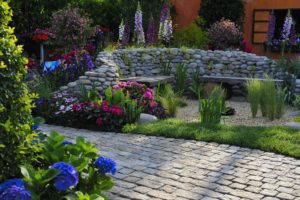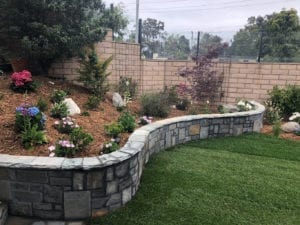When you embark on the journey of building a garden wall in your home, one of the most critical decisions you’ll face is selecting the right bricks. This choice isn’t just about aesthetics; it’s about creating a structure that will endure and enhance your outdoor space for years to come. Bricks, once in place, aren’t easily changed. Therefore, it’s essential to carefully consider factors such as color, size, texture, and bond to ensure that your garden wall not only fulfills its functional purpose but also adds to the beauty of your landscape.
To guide you through this important decision, we’ve put together a comprehensive guide with a range of considerations to help you make an informed choice.

1. Purpose and Functionality
Every garden wall serves a specific purpose. It might be a retaining wall to prevent soil erosion, a decorative boundary to enhance the aesthetics of your garden, or a raised flower bed. Determining the primary function of your garden wall is the foundational step that will guide your brick selection process.
2. Durability and Weather Resistance
Your garden wall will stand exposed to the elements year-round. It’s crucial to choose bricks that can withstand rain, frost, temperature fluctuations, and the test of time. Both clay bricks and concrete blocks are known for their resilience and durability, making them excellent choices. For example, clay bricks, often considered the gold standard for durability, are known to withstand weathering and can last for decades.
3. Aesthetic Appeal and Matching Existing Structures
The visual harmony of your garden wall is equally important. Consider the overall look and style you wish to achieve. Bricks come in various colors, sizes, and textures, offering versatility in design. You can choose from an array of colors, whether earthy tones that blend seamlessly with nature or bold hues that make a statement. Additionally, if your wall complements or integrates with existing structures in your garden, ensure that the chosen bricks blend seamlessly with the surroundings. Matching existing brickwork or hardscaping can create a cohesive and inviting outdoor space.
4. Budget Considerations
Define your budget early in the planning phase. Bricks come at varying price points, and while you’ll find options to suit different budgets, it’s essential to strike a balance between cost and quality to ensure long-term satisfaction. Keep in mind that while clay bricks may be initially more expensive, they can provide excellent long-term value due to their durability and timeless aesthetic.
5. Ease of Installation
The ease of installation varies by brick type. Concrete blocks, with their uniformity, are generally easier to work with. In contrast, clay bricks may require more skill and precision during installation. Assess your DIY capabilities and be open to professional assistance if needed. Precise installation is critical for the structural integrity and visual appeal of your garden wall.
6. Maintenance Requirements
Different brick materials have distinct maintenance needs. Concrete blocks are typically low-maintenance, while clay bricks may benefit from occasional sealing to enhance their lifespan and appearance. Choose bricks that align with your willingness to maintain them. Regular maintenance not only preserves the aesthetics but also prolongs the life of your garden wall, ensuring it remains an enduring feature in your outdoor space.
7. Environmental Impact
In an era of environmental awareness, consider the ecological footprint of your choice. Some brick manufacturers produce bricks with recycled content, reducing the demand for new resources. Additionally, local sourcing can minimize transportation emissions, further contributing to sustainability. Opting for environmentally friendly brick options aligns with modern principles of responsible landscaping and eco-conscious living, making your garden wall a sustainable choice for the future.
8. Customization with Brick Size and Bond Patterns
Brick size and bond patterns play a pivotal role in achieving your desired aesthetic. Smaller bricks offer opportunities for intricate designs and patterns, while different bond patterns, such as running bond, herringbone, or basketweave, can create unique visual effects. These creative possibilities allow you to craft a garden wall that is not only functional but also visually captivating, turning your outdoor space into a work of art.
9. Texture for Slip Resistance
If your garden wall is in an area prone to moisture or anticipated foot traffic, opt for textured bricks. These surfaces provide better traction and reduce the risk of accidents, making them ideal for steps or areas near a pool. Safety and functionality should be prioritized in these instances, ensuring that your garden wall serves its intended purpose while remaining safe for all who enjoy your outdoor space.
10. Brick Color for Temperature Control
The color of your bricks can influence the thermal properties of your garden wall. Darker bricks absorb more heat, making them suitable for retaining walls in cooler climates, while lighter bricks reflect heat and are better suited for walls in sunnier, warmer regions. This consideration extends beyond aesthetics to practicality, as it can impact the comfort of your outdoor space in different weather conditions, ensuring that your garden wall enhances both form and function.

In conclusion, the selection of bricks for your garden wall is a multifaceted decision that combines practicality and aesthetics. Take your time to explore the myriad options available, seek professional guidance when necessary, and remember that the perfect choice will not only enhance your garden’s functionality but also contribute to its enduring beauty and charm, becoming a testament to thoughtful planning and design. With the right bricks, your garden wall will stand strong and elegant, enriching your outdoor space for generations to come. The careful consideration you put into this decision will yield a garden wall that not only endures but also enriches your outdoor experience, creating a space of lasting beauty and utility in your home.
To have more ideas you can check out DIY Patio Pavers: Step-by-Step Installation Guide.


